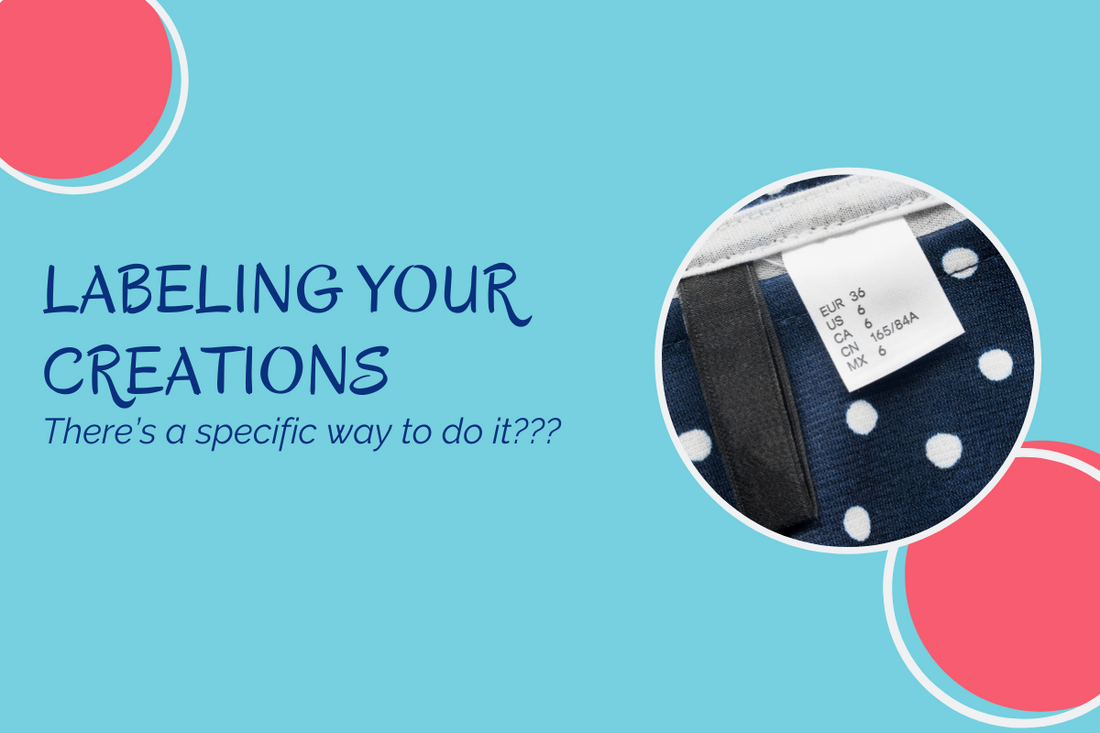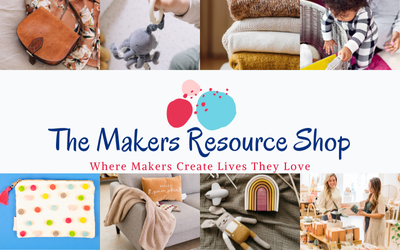
Labeling Your Creations
Sometimes the easiest things can give us pause in fear of missing something important.
Labeling is typically one of those things for many makers.
Today, I'll make sure to clear away some of that fear and overwhelm when you are trying to figure out how to label your products.
The agencies
First, it's important to know that there are many agencies that have rules for labeling most of the products we make.
- Federal Trade Commission (FTC)
- US Customs & Border Protection (CBP)
- Consumer Product Safety Commission (CPSC)
- Food & Drug Administration (FDA)
- and many more depending on the product!
Still, take a deep breath! Let's go through the agencies we usually deal with in the handmade niche.
Method of attachment
All information must be permanent except for fiber content which may be secure.
- Permanent means that the label can last the useful life of the product (through regular use and care)
-
Secure means that the label must last until the final consumer receives it (through shipping or being in a brick & mortar shop)
Information must also be available to be seen prior to purchase. In a brick & mortar shop, this will be on the package (or through the packaging). In an online shop, this will be within the description of the product. Packaging solely for shipping does not need to be marked.
Additionally, the information does not necessarily need to be sewn on. As long as it lasts, that's what matters, so it can be written, a stamp, an iron-on, preprinted onto material, etc.
What information is needed?
For most things, FTC & CBP cover the basics:
- Country of Origin ('Made in USA', 'Made in USA of imported materials', 'Made in Canada', etc.),
- identity of manufacturer or domestic importer (business name), and
- fiber content (95% bamboo viscose, 5% spandex; 100% cotton)
Care information is permanent and requried for all clothing items, regardless of size. This should include:
- How to wash. Such as by hand, spot clean only, machine wash & what temperature.
- Bleach warnings. Such as chlorine only, no bleach, etc.
- How to dry. Such as hanging, block drying, machine & what temperature.
- Iron warnings. Such as 'no iron', 'low iron', etc.
- Other warnings. Such as 'wash with like colors', 'wash inside out', 'close zipper', 'remove solids', 'remove child' (gotcha!)
Tracking information is a requirement from the CPSC and is required for all children's products (persons 12y and under). This will include:
- Identity of manufacturer or private labeler (business name, logo with name, etc.)
- Location of manufacturing (city and country)
- Date of manufacture (month and year)
- Batch of other unique code to assist in identifying each unique product
- Other information to ascertain the specific source of the product
I know. You probably looked at some of that and went
About that needed info
Let's break it down a few of those more confusing points.
First, it is important to note that all of this information does not have to be spelled out word-for-word. In guidance, the CPSC specifically states:
"The information may be in code form as long as the consumer knows who to contact in order to interpret the code and ascertain the required information." {source}
So keeping that in mind...
Location of Manufacturing
The purpose of this requirement is to narrow the scope of where a safety issue may have occurred.
Part of this requirement is satisfied with the Country of Origin requirement (Made in...). Note that the entire made in statement must be together, must be in the same size and style lettering. No part of it can stand out more than another part. So no MADE IN USA of imported materials. It all needs to be capitalized, every first word capitalized, or none of it capitalize (except the name of the location, of course)
Some makers will state 'Made in City, Country of imported materials', but as we are allowed to put information in code form, you may leave it without the city and encode the city as part of your batch.
If you have a sewing team, you'll perhaps add an identifier to your batch code such as 'TN' for your sewing person in Tennessee and 'GA' for your sewing person in Georgia. If you have two people in Tennessee, you might have 'TN1' and 'TN2' to identify each separately.
But if you are a one person show, then this addition to your batch is moot. There's only one place that an error could have occurred, so there is no reason to add anything to your batch.
The Country of Origin must be placed at the back-center of a product that has a neck or waist and must not be obscurred by any other label or material. Additionally, it is important to be truthful and transparent. If your product is put together in the USA using US-printed fabric that was milled in India, you would label with one of the following:
- Made in USA of materials from India
- Made in USA of imported materials
- Made and printed in USA with imported materials/materials from India
You may also clarify the steps such as 'Designed in USA, Made in China' or 'Made in Indonesia, Embellished in USA'.
Date and Batch
I have these together because the important part is the date. The 'batch' can literally be anything... including the date itself.
And, I know you are likely thinking "Um, I don't make batches??? I make one at a time or one of a kind things." That's okay!
- A 'batch' can be just one item.
- A 'batch' can be a group of different items made with the same materials.
- A 'batch' could be a group of like items made in a specific time frame
- A 'batch' could be a group of different items made in a specific time frame.
The idea behind the batch is to further narrow down the scope of investigation should a question need to be answered about the product.
If you keep track of your component inventory and your finished product inventory, you likely can answer any question about any product given just a date and a description/image of the product. This is why the date, alone, is fine for the batch.
Other information to ascertain the specific source of the product
The CPSC has a question of 'is the information ascertainable if I mark my product with a code and website' and the answer is:
"Yes, provided the name of a manufacturer, importer, or private labeler is also identified so a consumer without access to the internet can know whom to contact directly to also obtain the required information." {source}
Your business name (or logo with name) is already on the label, so adding a website simply further satisfies this part of the requirement. Some people like to put an email address or a mailing address. What you do is up to you, there is no specific 'correct way' for this.
That's it!
That's labeling. There are other labels for small parts warnings, sleepwear, and other state requirements (like stuffed toys & bedding), but that's the bulk of what you'll be looking at when making your products.
If you'd like your label checked before having them printed or your stamp made, post a mockup or an image in the free community!
For product specific and step-by-step information, check out the digital books in the shop!
More help is available
- Come hang out with other makers in our free community.
- Get guaranteed and specific support with The Makers Community
- Pick up your free checklist to get you started
